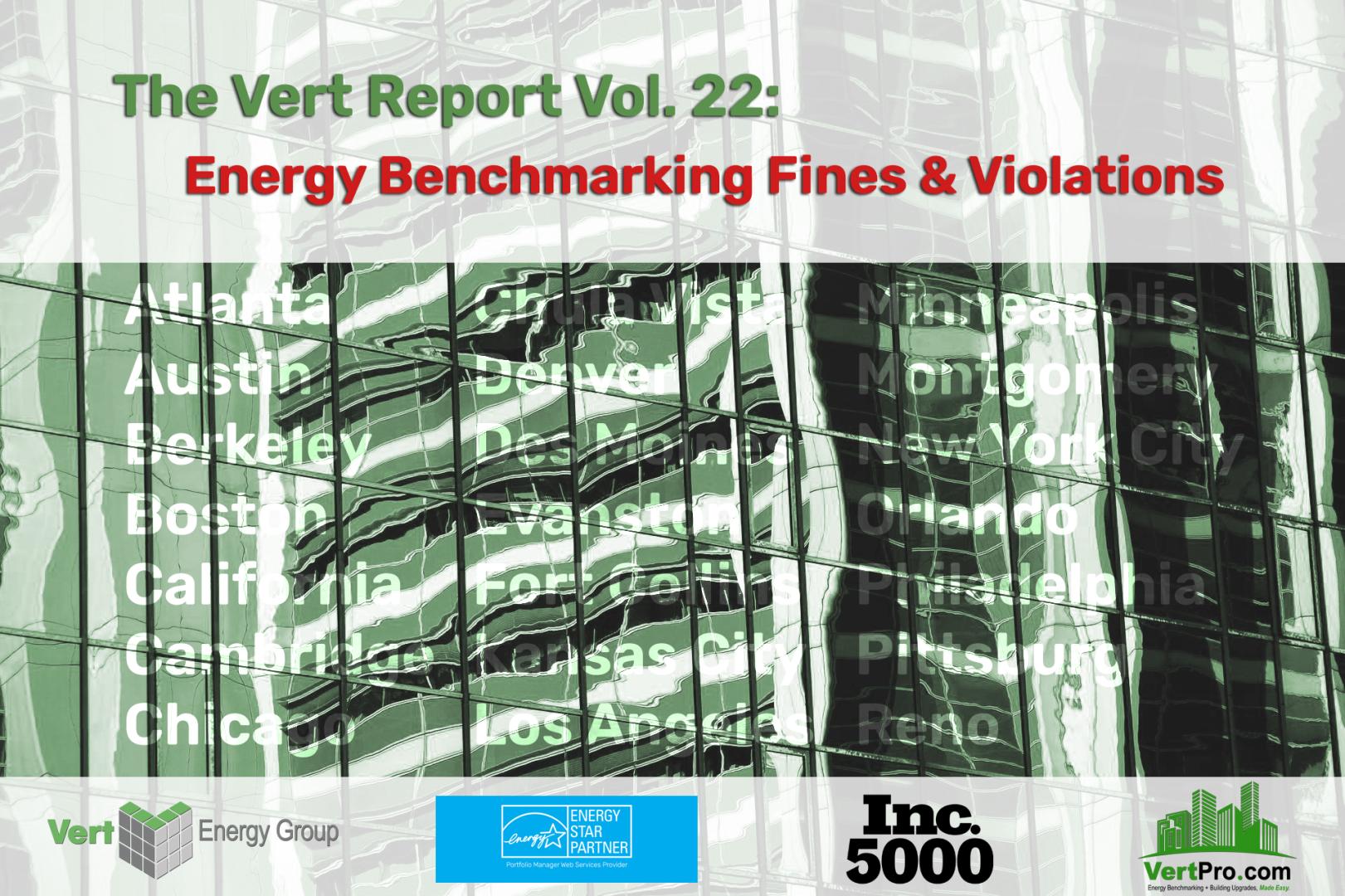City/State Energy Benchmark Fines and Violations for Non-Compliance
Every year, building owners and managers are faced with the responsibility of ensuring their property is in compliance with their local city or state Energy Benchmark programs. Many of these Benchmark programs have penalties in place to enforce annual compliance. Failure to file required energy usage data can result in written warnings and/or monetary fines. Fines and violations for non-compliance can add up quickly, so it’s important to be aware of the most common infractions. The following is a complete chart of Benchmark programs with existing penalties for non-compliance:
Benchmark Program | Annual Deadline | Penalty for |
Atlanta Commercial Buildings Energy | June 1st | $1,000 |
Austin Energy Conservation Audit & | June 1st | $500-2,000 |
Berkeley Building Energy Saving Ordinance | July 1st | $100-1,000 |
Boston Energy Reporting & Disclosure | May 15th | $35-200 |
California Assembly Bill 802 (CA AB802) | June 1st | $500-2,000 |
Cambridge Building Energy Use Disclosure | May 1st | $300/day |
Chicago Building Energy Use Benchmarking | June 1st | $100 + $25/day |
Chula Vista Building Energy Saving | May 20th | $750-2,250 |
Denver Commercial & Multifamily | June 1st | $2,000 |
Des Moines Energy & Water Benchmarking | May 1st | $50 + $300-500/day |
Evanston Building Energy & Water Use | June 30th | $100 |
Fort Collins, CO Ordinance 144 Building | March 1st | $1,000 |
Kansas City Energy Empowerment Ordinance | May 1st | Written Warning |
Los Angeles Energy & Water Efficiency | June 1st | $202 |
Minneapolis Commercial Building Rating | June 1st | Written Warning + Civil Fine |
Montgomery County Building Energy | June 1st | Written Warning |
New York City Local Law 84 (NYC LL84) | May 1st* | $500-$2,000 |
Orlando Building Energy & Water | May 1st | Written Warning |
Philadelphia Building Energy Benchmarking | June 30th | $300 + $100/day |
Pittsburgh Building Benchmarking Ordinance | June 1st | Publicly listed non-Compliant |
Portland Energy & Water Use Performance | May 1st | $20/day |
Portland Commercial Building Energy | April 22nd | $500 |
Reno Energy & Water Efficiency Program | April 1st | $850 |
Saint Louis Building Energy Awareness Bill | April 1st | $50-1,000 |
Salt Lake City Elevate Buildings | May 1st | $500-1,000 |
San Francisco Existing Commercial Buildings | April 1st* | $50-2,500 |
Seattle Council Bill 116731 (CB116731) | July 1st | $150-500/day |
*Note: New York City and San Francisco have extended the 2022 deadlines to May 31st and May 15th respectively to accommodate for issues with the utilities and/or their systems.
While not all Benchmark programs issue written warnings and/or monetary fines, each city and state agency keeps records of compliance statuses year-to-year. Some of these records are made public via a compliance list. These public compliance lists are in place to hold all appropriate parties accountable and aware of their need to comply. You can often locate these public lists directly via your respective city/state Benchmarking website or by contacting your local program’s support line directly.
For New York City building owners, it is important to note that non-compliance by the May deadline will not only result in a $500 violation but will also impact your Local Law 33 (LL33) Energy Grade. Failure to accurately file by the May deadline will automatically result in an LL33 Energy Grade of an F indicating failure to comply. Per the LL33 ordinance, your Energy Grade must be printed and displayed in a conspicuous location near each public entrance on the property. That means an Energy Grade of an F will be in clear sight for all occupants and visitors for an entire year until the new LL33 grades are released the following year.
Whether or not your local Energy Benchmark program has violations, Benchmarking is a key component in maintaining energy efficiency standards for your building while reducing your environmental impact. Avoid further penalties and fines by getting your building Benchmarked. If you’re looking for an easy way to get started and into compliance, Vert Energy Group can help. We specialize in aiding businesses and owners with their annual local Energy Benchmark requirements. Visit VertPro.com/Benchmark-Help to get started today.
“The risk management on the front end of things are hard dollars sometimes for owners to spend. It’s kind of like putting a new roof on your house. You have to do it, otherwise you can save the money but eventually it’s all going to catch up to you.” – Michael Klutho
NYC Local Law 11 (LL11) - Facade Inspection & Safety Program
 Under NYC Local Law 11 (LL11), all buildings with six or more stories must undergo an inspection of the exterior walls and appurtenances every five years. This inspection falls under the city’s Façade Inspection and Safety Program, or FISP, which aims to improve public safety by identifying potential problems with building exteriors. During the inspection process, a licensed professional will examine a wide range of material and structural features on the building envelope. These may include windows, doors, masonry, and cladding materials, as well as waterproofing membranes and rooftop vents. The overall goal of FISP is to help ensure that New York buildings are safe and structurally sound while minimizing any potential risks to the property and its occupants. If any issues are identified during the inspection process, they will be flagged so that they can be promptly addressed by qualified contractors.
Failure to comply with LL11 will result in civil penalties issued by the New York City Department of Buildings (NYCDOB). In extreme cases, NYCDOB can revoke a building’s Certificate of Occupancy and force it to be closed if it is not in compliance with LL11 as the building will be deemed unsafe. There are four different civil penalties you can receive:
Under NYC Local Law 11 (LL11), all buildings with six or more stories must undergo an inspection of the exterior walls and appurtenances every five years. This inspection falls under the city’s Façade Inspection and Safety Program, or FISP, which aims to improve public safety by identifying potential problems with building exteriors. During the inspection process, a licensed professional will examine a wide range of material and structural features on the building envelope. These may include windows, doors, masonry, and cladding materials, as well as waterproofing membranes and rooftop vents. The overall goal of FISP is to help ensure that New York buildings are safe and structurally sound while minimizing any potential risks to the property and its occupants. If any issues are identified during the inspection process, they will be flagged so that they can be promptly addressed by qualified contractors.
Failure to comply with LL11 will result in civil penalties issued by the New York City Department of Buildings (NYCDOB). In extreme cases, NYCDOB can revoke a building’s Certificate of Occupancy and force it to be closed if it is not in compliance with LL11 as the building will be deemed unsafe. There are four different civil penalties you can receive:
|
Issue/Reason for Penalty |
Penalty Fee |
|
Late Filing of the initial LL11 report |
$1,000/month |
|
Failure to File the initial LL11 report |
$5,000/year |
|
Failure to correct unsafe conditions |
See second chart |
|
Failure to correct SWARMP conditions |
$2,000 |
|
Penalty Fees for Failure to correct unsafe conditions |
|||
|
|
Base Penalty |
Plus |
|
|
Year 1 |
$1,000/month |
N/A |
|
|
Year 2 |
$1,000/month |
$10/linear foot (l.f.) of shed/month |
|
|
Year 3 |
$1,000/month |
$20/linear foot (l.f.) of shed/month |
|
|
Year 4 |
$1,000/month |
$30/linear foot (l.f.) of shed/month |
|
|
Year 5 |
$1,000/month |
$40/linear foot (l.f.) of shed/month |
|
|
Last Digit of NYC Block Number |
Cycle |
LL11 Begins |
Initial LL11 Deadline |
|
4, 5, 6, and 9 |
A |
February 21, 2020 |
February 21, 2022 |
|
0, 7, 8 |
B |
February 21, 2021 |
February 21, 2023 |
|
1, 2, 3 |
C |
February 21, 2022 |
February 21, 2024 |
Fun Fact: 3pm is the official time of observance every Memorial Day in the U.S.
Memorial Day
 Memorial Day falls on May 30th this year. This American holiday began in the years following the Civil War to remember and honor the brave men and women who have given their lives in service to our country. It is a day of somber reflection, but also of celebration and thanksgiving. Over the years Memorial Day traditions have evolved. Originally, people would observe the holiday by decorating the graves of fallen soldiers and it grew into local and national celebrations with parades. With many offices and companies closed on Memorial Day, this holiday has become more of a long weekend referred to as “Memorial Weekend.” It serves as an opportunity for many to take a weekend trip or host parties in what National Today states is a way “to balance out the soberness of the day and welcome summer.” Whether you’re staying in or taking a trip this Memorial Day, take a moment to pay tribute to honor the brave men and women who have given their lives in service to our country.
Memorial Day falls on May 30th this year. This American holiday began in the years following the Civil War to remember and honor the brave men and women who have given their lives in service to our country. It is a day of somber reflection, but also of celebration and thanksgiving. Over the years Memorial Day traditions have evolved. Originally, people would observe the holiday by decorating the graves of fallen soldiers and it grew into local and national celebrations with parades. With many offices and companies closed on Memorial Day, this holiday has become more of a long weekend referred to as “Memorial Weekend.” It serves as an opportunity for many to take a weekend trip or host parties in what National Today states is a way “to balance out the soberness of the day and welcome summer.” Whether you’re staying in or taking a trip this Memorial Day, take a moment to pay tribute to honor the brave men and women who have given their lives in service to our country.
Fun Fact: According to a 2021 YouGov poll, the most popular Mother’s Day gift that mothers wanted were flowers followed closely by sharing a special experience with their family.

Danielle’s Corner
Mother’s Day Happy Mother’s Day to all the mom’s out there! Did you know that Mother’s Day was originally meant as a day to protest wars? In 1870, Julia Ware Howe wrote the Mother’s Day Proclamation calling for the end of wars. Howe originally intended the day to be for mothers of different backgrounds to come together to protest war and fight for peace. While that idea didn’t necessarily take off and become tradition, there are still some who do partake in protests in honor of the holiday. WomansDay.com makes honorable mention of the 1982 Lawrence Livermore Library at the University of California protest in which a large group of women came together to protest nuclear weapons. The more common ideology of Mother’s Day stems from Anna Jarvis. On the second Sunday in May of 1907, Anna Jarvis held a service to honor her mother, Ann Reeves Jarvis, who had passed away in 1905. A year later, in 1908 on the second Sunday of May, Jarvis holds another service to honor her late mother and passes out flowers to all who attend. This kickstarts Jarvis’ goal to make Mother’s Day official which as we know she accomplished in 1914 when President Woodrow Wilson makes the second Sunday each May the official Mother’s Day. To this day, flowers are one of the most popular gifts bought on Mother’s Day as we honor our own mothers. This Mother’s Day is sure to thank your mom and/or the mother figure in your life for all the love and support they have given you. I know I’ll be showering my mom with many thanks for putting up with my rebellious teen years. Search by Zip to Find Applicable Energy Laws
Search by Zip to Find Applicable Energy Laws
There are over 30 cities/states with Energy Benchmark requirements - 16 have Energy Audit requirements as well! Use this free tool to check if your building has an upcoming Energy Benchmark or Energy Audit deadline.
FIND OUT HERE »
